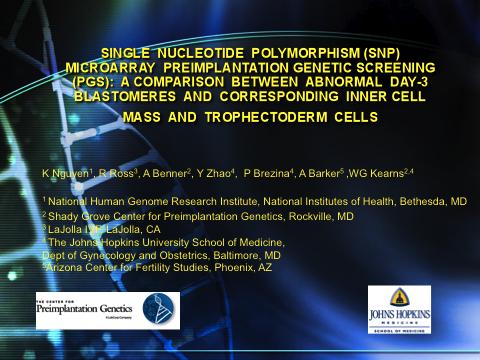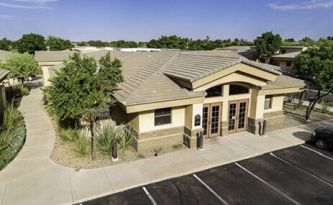What's New in Fertility Studies Arizona Center for Fertility Studies
Published: 12/14/2015
PGD: 23-Chromosome Microarray Study
Arizona Center for Fertility Studies was part of a multiple center study, recently presented at ASRM October 2010 (American Society of Reproductive Medicine), looking at the efficacy of PGD: 23-chrosomome microarray, a technique to scan the genome for gains and losses of chromosomal material. This method has significantly high resolution and clinical yield. This new analytical technology, microarray analysis, allows for the evaluation of all 23 pairs of human chromosomes on a single cell.
While advances both in methods and drugs used for ovarian stimulation as well as improvements in embryo culture techniques have undoubtedly had a positive influence, IVF success rates have lagged and even stagnated over the last 10 years . This is largely due to an inability to reliably identify and selectively transfer only "competent" embryos (those that are capable of producing a healthy baby) to the uterus. Even in young women, an embryo that "looks good" under a microscope is not necessarily competent. At best, it has a 25% chance of implanting. Furthermore, this statistic shrinks with advancing age beyond 35 years. Even the use of preimplantation genetic diagnosis using fluorescence in-situ hybridization (FISH) (PGD/PGS- old technology) to identify chromosomes does not significantly improve this capability and is limited to testing 5-10 chromosomes. As a result, many IVF specialists still transfer multiple embryos at a time to increase the odds that at least one competent embryo will reach the uterus and produce a pregnancy. The problem is that while this improves the chance of a pregnancy occurring, it also markedly increases the risk of multiple gestations pregnancies.

It is, however, an undeniable fact that reproductive failure (i.e. failed implantation, miscarriages and major birth anomalies) are far more likely to be due to embryo incompetence (70-75%) than to a lack of uterine receptivity (25-30%). It is mostly (but not exclusively) the embryo's chromosomal configuration that will determine its "competence". The number of chromosomes in a cell is referred to as its ploidy. A cell with a normal number of chromosomes is referred to, as euploid, while one with an irregular chromosome number is aneuploid. It appears that it is the ploidy of the mature egg (rather than the sperm) that determines the post-fertilization chromosome configuration of the embryo. The embryo's ploidy, in turn, determines its competence.
Recently, a newer technology has emerged that has appears much more promising in its ability to deliver complete genetic (all the embryo's chromosomes) information about an embryo in question. This technique is referred to as PGD/PGS: 23-chromosome microarray.
In contrast to FISH, PGD/PGS: 23-chromosome microarray is able to provide information about all 24 chromosomes (22 pairs plus X and Y) from a single cell, which has been removed from a 3-day or day 5/6 (blastocyst) old embryo. Arizona Center for Fertility Studies believes it is likely that 23-chromosome microarray will replace FISH for this reason and hopefully will actually be able to improve the efficiency of In Vitro Fertilization by improving pregnancy rates while limiting the occurrence of miscarriages, by only transferring chromosomally competent morphologically normal embryos back into the uterus.
ARIZONA CENTER FOR FERTILITY STUDIES STRONGLY BELIEVES THAT PGD/PGS: 23-CHROMOSOME MICROARRAY COULD CHANGE THE FUTURE OF IVF.
WE FEEL SO STRONGLY ABOUT THIS TECHNOLOGY AND HOW IT COULD SIGNIFICANTLY IMPROVE OUR IVF SUCCESS RATES THAT ARIZONA CENTER FOR FERTILTIY STUDIES HAS DECIDED NOT TO CHARGE FOR THIS PROCEDURE (other than what the PGD lab charges us - $2,400) IN ORDER THAT ALL PATIENTS DOING IVF CAN BENEFIT FROM THIS VERY EXCITING NEW TECHNOLOGY
THE HIDDEN COSTS OF TRAVELING FOR IVF TREATMENT

By Global IVF
There are lots of clinics, websites and patients raving about the financial savings when traveling abroad for fertility treatments. HOWEVER, when considering this option, you need to be aware that there may be some hidden costs that you need to consider before you pack your suitcase. For instance:
MEDICATIONS:
A fresh In-Vitro Fertilization (IVF) cycle for under $5000. Sounds great, right? But does that include the medications? Some clinics will figure them into your total fee, but others don't since they assume you'll purchase the medications at home. If you have to buy them in the U.S. - you are probably adding about $3000-5000 to your bottom line (unless you are lucky enough to have insurance coverage.) Some clinics will give add in the costs of medications in their local country (which are typically much less expensive than in the U.S.) - but it is often difficult to ship them and some patients worry about the quality or temperature variations during the shipping process. Still, you can consider purchasing some of your medications in your home country (to start the cycle) and purchasing the rest once you arrive in the location where you will do the cycle. This will help to cut down the overall cost. More importantly, when figuring out your bottom line do make sure to ASK whether or not medications are included in the In-Vitro Fertilization (IVF) cycle fee.
AIRFARE:
When budgeting an In-Vitro Fertilization (IVF) cycle at home, typically your travel costs will only include gas mileage. If you have to go one or two or more times to the clinic per cycle, for repeat ultrasounds or lab work, it's not usually a big financial drain. But when looking to go abroad, some clinics request that you come two times at a minimum - once for the initial evaluation and again for the egg recovery and embryo transfer. Sometimes you can ship sperm but some clinics request that the sperm "donation" be made at the clinic. Also, as difficult as it is to think about, you have to consider the possibility of what happens if your cycle doesn't work on the first try. Will you be able to go to your overseas clinic for another attempt - and if so, how much is that going to set you back in airfare costs? Of course, you may be lucky enough to have loads of frequent flier miles (so many of us have by putting most of our fertility charges on credit cards!), but you usually have to book those trips way in advance and that may be inconvenient to your In-Vitro Fertilization (IVF) cycling plans. Still, there are plenty of low-fare websites and travel agencies that you can check for last minute (or close to last minute) deals.
TRAVELING COSTS:
Okay, we talked about airfare, but that's just getting in the air and landing at the airport. What happens once you're on the ground in this foreign country? So, don't forget to add in car rental or taxis to and from your clinic (or anywhere else you might want to go), food (check the exchange rate and the cost of an average meal), plus hotels or accommodations. There are some countries where great food is cheap, but others where a cup of Joe can run you $12. If you do your research, you can typically find a more reasonably priced place to stay - and perhaps one that has a kitchenette so that you can cut down on food costs by eating a meal or two at home. Your clinic may even have a discounted rate at some local hotels - so don't be too shy to ask. You should also remember to budget in a day or two of sightseeing - yes, you are here with the specific goal of making a baby, but you might as well do some sightseeing in your time off.
GETTING AWAY:
Even though you may be using a passport and going to an exotic location, it's not really a vacation. So if you work, how are you going to handle it? Are you going to use some of your vacation time or will you be giving up a paycheck? Is your employor okay with you taking the time off or will you have the extra added stress of checking in from overseas? These are very personal decisions but not ones that are necessarily dealt with when the initial decision to travel for In-Vitro Fertilization (IVF) or ART is made. Also, you are most likely going to be monitored at a local clinic near your home or work (if you are using your own uterus and/or own eggs), so don't forget to figure in some time away from work for that.
LOCAL MONITORING:
Speaking of local monitoring, it is more than likely that you will need to find someone (either an RE or your OB/GYN) to assist in some local monitoring and tests during your cycle. The costs for these vaginal ultrasounds, hormone level blood work checks and any other testing needed prior to your travelling is another thing to consider in your overall costs. Sometimes your insurance will cover this - so don't forget to call and ask.
MORE THAN ONE ATTEMPT and SUCCESS RATES:
Sadly, this is something you must think about (even for the most positive amongst us!) - what if you don't get pregnant on the first try? It is sometimes very hard or even impossible to get accurate information on the clinics success rates. "Telling" you their success rates and actually seeing them documented in a reliable source may be two different things. If you're using a gestational surrogate and you have left over embryos then this is a non-issue, you won't have to go back for the second try, your gestational surrogate will most likely already be in place for the second attempt. But if you have used your own eggs or an egg donor's (and putting them back into your own uterus), then you'll be faced with deciding what to do next. Should you go back? Should you ship the embryos home? Each choice comes with its own set of costs, and even with a clinic with a great success rate, there is no guarantee it will work on the first try.
FREEZING:
So, let's say your first try works (Yeah! You're pregnant!), but you've left behind some frozen embryos that you may very well like to use in the future. We can guarantee you that your distant (as well as your home) clinic is going to have a freezing and storage charge (also for sperm). So don't forget to ask what it is and factor in paying for it for a couple of years. Okay, so by now you may be thinking, maybe this seems like we're saying traveling for treatment isn't such a good idea. I guess that you need to decide. Arizona Center for Fertility Studies does not encourage this option but if you "must" make sure to check it out thoroughly. There have been a lot of "scam" clinics offering deals "that seem to good to turn down" and although there are overseas clinics that are highly reputable; if choose this option, please do your homework. When considering this option, you need to know all of the plusses and the minuses and not get blind-sided when you're too far in to turn back. A happy patient is an informed patient (and of course a pregnant patient!)
New test available at Arizona Center for Fertility Studies to determine the sex of your baby
A new test was recently released that can accurately determine the sex of your baby at 10 weeks gestation. Studies have shown that in 85% of pregnancies, the baby's sex was known prior to giving birth. Almost all were determined by ultrasound examinations prior to or around 20 weeks. These ultrasounds, although accurate, are not 100%. Studies indicated the following statistics that influenced the decisions to know the sex of the baby:
- 90% of woman wanted to know the sex of their baby
- 79% of partners wanted to know
- 64% wanted to be able to choose the baby's name
- 46% wanted to plan the nursery
- 43% of older children and/or relatives wanted to know to baby's sex
- 9% for genetic and/or health concerns like Fragile X and other X-linked disorders
The test is performed using the pregnant woman's blood, drawn at about 10 weeks gestation to optimize accuracy. Earlier testing will be less accurate. Currently, Sequenom CMM (Center for Molecular Medicine) shows 100% accuracy at 10 weeks gestation. The test is based on detecting the presence of fetal DNA in the maternal plasma. Using PCR (polymerase chain reaction) technology, the test can detect and identify the SRY gene and multicopy DYS14 marker sequences consistent with Y- bearing or male chromosomes. In the absence of this detection, the fetus is assumed to be female. In order to decrease the risk of a false positive, an ultrasound should be done to rule out the possibility of a missed and/or vanishing twin pregnancy, which could introduce fetal DNA from a non -viable pregnancy. Pregnancy outcome and fetal sex, as determined by chromosome testing, ultrasonography, or after birth were ascertained. SYR and DYS14 PCR were positive in 105 of 105 plasma samples of women bearing a male fetus; and in all 81 plasma samples of women bearing a female fetus, PCR for SRY and DYS14 was negative. However, with any test result, there is always the risk of false positives and/or false negatives.
Arizona Center for Fertility Studies now offers this test to all couples who want to know the sex of their baby early in their pregnancy for personal reasons, to eliminate the potential inaccuracy of ultrasound, for genetic and/or health concerns and to avoid the risks associated with amniocentesis and/or CVS.
The cost is $395
Please call the office with any questions at (480) 860-4792.
The use of human growth hormone at Arizona Center for Fertility Studies
At Arizona Center for Fertility Studies, we have found one additional option that has proven successful in patients attempting In-Vitro Fertilization (IVF) - that is the addition of human growth hormone or hGH to the treatment protocol. It is a known fact that hGH is a cogonadotrophin and, like FSH and LH, is absolutely needed for the full and final maturation of an egg. Although, if measured, a patient will have a normal level of hGH in the blood, some patients do not have enough hGH for all the extra eggs that they make. These patients are impossible to identify "up front" but young patients that make a lot of eggs and have poor fertilization rates or do not get pregnant as expected; or women over the age of 38-39, in Arizona Center for Fertility Studies experience, and backed up by the scientific literature, seem to have better success rates when adding hGH to their treatment protocol. At Arizona Center for Fertility Studies, it is now our policy that all women 38 or older are offered the option of using hGH, as part of their starting protocol for In-Vitro Fertilization (IVF).
Egg freezing (vitrification) at Arizona Center for Fertility Studies
Egg or oocyte freezing has been around for years, but up to a few years ago was only available as an experimental technique of fertility preservation, and with limited success. While embryo cryopreservation (freezing) has been successful for the last two decades, freezing unfertilized eggs or oocytes is trickier. Eggs are more susceptible to damage from ice crystallization than embryos during the freezing process. Up to a few years ago, a young and/or single cancer patient who wanted to preserve her future fertility, only had the option of fertilizing her own eggs with donor sperm. Also, some couples were faced with the moral and/or religious beliefs in having to decide what to do with multiple unused embryos. A third concern, were from young women, either single or married, that wanted to delay childbearing but were concerned about "getting too old and/or having problems" with resulting increased difficulty with achieving pregnancy; or at being at increased risks of chromosome abnormalities and miscarriages if they delayed childbearing for too long.
With these newer techniques of rapid egg freezing, or vitrification, it is now possible to cryopreserve the female egg (oocyte), as successfully as it has been to cryopreserve sperm. Egg freezing is still a new and mostly experimentally technology that has been shown to be highly effective in preliminary research. There are now a number of babies born with the use of egg vitrification technology; and Arizona Center for Fertility Studies now offers egg freezing for patients needing or choosing to preserve their future childbearing potential. We have had good results with vitrification of eggs. To date, there have been no increase in birth defects related to this process. Survival rates for eggs (oocytes) can reach as high as 85% and pregnancy rates as high as 65%, depending on the woman's age. Pregnancy rates with egg vitrification, with subsequent thawing and fertilization, should be similar to success rates with that of frozen-thawed embryos. Once thawed, the egg can be fertilized using ICSI, an assisted reproductive technology, that injects one sperm directly into an egg.
Sex selection
Although never intended for this use, a popular use of PGD/PGS (preimplantation genetic diagnosis) at Arizona Center for Fertility Studies is for gender selection, or to determine the sex of the embryo for "family balancing", or motivated by social, psychological or cultural reasons. There is an ongoing controversy about using the PGD/PGS technology for determining the sex of the embryos. Not that there is necessarily an argument against family balancing or "wanting a boy rather than a girl", it is more of what is done with the embryos of the undesired sex? If these "unwanted" embryos are donated anonymously to another couple, that is one thing; but many times they are discarded, raising all kinds of moral, ethical, religious, spiritual and psychological issues for the parents, the clinic and their staff and society as a whole. Arizona Center for Fertility Studies respects a couple's right to choose and, although encourages anonymous donation of "extra embryos", will honor the couple's choice to do PGD/PGS for sex selection and their decision on disposition of the extra embryos.
Sex selection requires a couple to do In-Vitro Fertilization (IVF) with ICSI in order to obtain multiple embryos to perform PGD/PGS for gender selection. This makes "having a boy or girl" an expensive procedure; and yet, a couple's right to decide. Arizona Center for Fertility Studies has done numerous PGD/PGS procedures for sex selection with very good success rates. PGD/PGS is 99.99% accurate in determining the sex of each embryo; thus allowing the couple to accurately choose the gender they desire. To date, there are thousands of babies born, who as embryos underwent PGD/PGS for sex selection, with no reported statistical increase in birth defects or other identifiable problems.
Removal of fibroids with morcellation
In the past, when hysteroscopy was done to remove a filling defect, small instruments were put through the operating channel of the hysteroscope and the filling defect was either grasped or cut or both. Due to the small size of the hysteroscopic instruments, the surgery was many times difficult, could take 2+ hours to complete, and at times, not be able to even remove the filling defect. This was more common with larger fibroids that were partially embedded in the underlying muscle. In the last 4-5 years, hysteroscopic surgery has experienced a significant breakthrough in technology on how the procedure can be done. This is the use of morcellation technology. Having been used in orthopedic surgery, the hysteroscopic morcellator can simultaneously cut and aspirate tissue; thus, greatly reducing operating time, being able to remove large fibroids that previously were so big and difficult that they had to be removed by an open incision, collect the entire specimen in a trap to be sent to pathology for confirmation, and eliminating pieces of tissue floating in the endometrial cavity sometimes interfering with visualization. The morcellator works on a mechanical design and eliminates the risk of electrical energy in the uterus and thermal damage to surrounding normal endometrial tissue, which other types of hysteroscopic procedures use. Tissue is cut and captured under continuous visualization to ensure efficient and complete removal of the entire filling defect, whether it is a polyp or fibroid. Targeted, visualized treatment reduced the risks of endometrial damage, provides greater control over "blind procedures", where not all of the filling defect can initially be visualized, and greatly reduces the risk of uterine perforation, since the tip of the morcellator is blunt, as well as the entire shaft of the instrument, except for a small window, where the cutting blade is. It also works with an extremely accurate fluid management system that tracts the amount of fluid in and out, especially during a longer procedure, like a large fibroid, which is very important to avoid patient fluid overload.
The hysteroscopic morcellator has reduced procedures that would have taken 1-2 hours, if they could be done, down to 25-35 minutes with minimum to no damage to the uterus and surrounding tissue. The primary goal with hysteroscopic surgery, is not removing the filling defect, but to preserve the integrity and normal architecture of the uterus.
Arizona Center for Fertility Studies believes that no hysteroscopic procedure should be not without the use of the morcellator. It is state-of-the-art technology and the first time that technology has come along that makes a profound difference, which really has revolutionized hysteroscopy.
Antiphospholipid Antibodies
Antiphospholipid antibodies (APA)- these are antibodies against the fatty part of the blood vessel wall and, if elevated, can prevent pregnancy or increase the risk of a miscarriage. All blood vessel walls are made up of fatty cells known as phospholipids. In some women, especially those having problems conceiving, there is the production of antibodies against these phospholipids, or antiphospholipid antibodies or APA. These antibodies can attack the blood vessel wall and damage it. Any time a blood vessel wall is injured it heals by making a small clot that patches the wall and begins the healing process. In the major blood vessels of the body, these micro-insults and micro-clots are of no consequence, but in the small tiny blood vessels of an early developing pregnancy, the clot can be larger than the blood vessel and hence block off blood flow to the pregnancy, resulting in losing the pregnancy between ovulation and your period or worse, miscarrying between 6-8+ weeks when there is an increase demand for blood flow for nutrients to the baby and most of the blood vessels are blocked off. Testing is controversial and most clinics do not test for antiphospholipid antibodies (APA) unless you have a history of repeated pregnancy loss, in which case, you may test positive for these antibodies. The argument is that fertile women can also test positive for APA and yet have no problems with conception or carrying a pregnancy to term. This is true, although, almost all programs will not do the test until after you have 2 or more pregnancy losses. Why wait until you have 2 documented pregnancy losses before doing the test? Arizona Center for Fertility Studies believes it is better to be proactive than reactive and strongly recommends APA as part of the initial work-up; not to mention the emotional and physical trauma of losing 2 or more pregnancies that possibly could have been prevented.
Antisperm Antibodies
Antisperm antibodies (ASA) - these are antibodies against human sperm, and not specifically, the woman's partner. They are elevated in 1-6% of woman having difficulty with conceiving. If elevated, these ASA may bind with sperm anywhere in the reproductive tract; vagina, cervix, uterus or fallopian tube, and thus immobilize them resulting in the sperm's inability to fertilize the egg. There is also evidence to suggest that ASA can attach to the paternal contribution and the embryo, and thus increase the risk of a miscarriage. This test, like APA, is also controversial. There are a small percentage of fertile woman who test positive for ASA but have no trouble with conceiving or carrying a pregnancy to term. However, if you are having difficulty with conceiving, thinking about doing IUI (intrauterine insemination) and/or have a history of repeated pregnancy loss, Arizona Center for Fertility Studies feels strongly that this test should be done, and, if positive, the woman should be given the choice for treatment or not to put sperm in the reproductive tract and think about the option of putting embryos in instead In-Vitro Fertilization (IVF). The treatment is low dose prednisone, that sometimes is very effective in lowering the percentage of antibodies against the sperm, and thus allowing for natural conception or to proceed with IUI and not have to worry about the possibility that the ASA will attack the sperm. At Arizona Center for Fertility Studies, antisperm antibody testing is recommended at part of the initial evaluation.
Value of Antioxidants in Sperm DNA
A new study confirms evidence from previous studies suggesting that men who eat foods high in antioxidants can reduce damage to their sperm's DNA. Infertile men have more sperm DNA damage than fertile men. It is also well established that sperm DNA damage is associated with elevated levels of very small, oxygen containing molecules known as reactive oxygen species. Some studies have suggested that a subset of infertile men may be at a risk for antioxidant deficiency, particularly vitamin C deficiency.
This study reviewed the evidence from available studies on the effects of dietary antioxidant supplementation on sperm DNA quality, concluding that the current evidence supports the beneficial effects of antioxidant supplementation on improving sperm DNA, even though the exact mechanism of dietary antioxidants has not been established.
One of those previous studies shows that vitamin C increase semen vitamin C levels and improves sperm DNA quality in men with vitamin C deficiency. In addition, 5 studies demonstrate that antioxidant therapy improves sperm DNA integrity and/or pregnancy rates. Therefore, Arizona Center for Fertility Studies recommends that in men with decreased sperm parameters the use of vitamin C "may" be beneficial. At least, it will not harm anything. Men should take 1000mg of time-released vitamin C twice to three times a day.
(Zini A, et al. Journal of Assisted Reproductive Genetics. 2009 Sept 19)
Patient to Patient Support Program
Arizona Center for Fertility Studies has recently created a patient to patient support program. New patients are sometimes overwhelmed by all the information and procedures that can be associated with infertility evaluation and treatment; and sometimes feel alone, isolated and "like they are the only ones with this problem". Recognizing this concern and realizing that a couple may need more than the explanations and mechanisms behind the treatments, Arizona Center for Fertility Studies has initiated a patient to patient support network. This is where patients that have been through similar procedures and have had similar feelings, emotions, fears and apprehension, can call and talk to patients that are "full" of questions and feeling the anxiety of the process. Many of Arizona Center for Fertility Studies patients that have been successful with their treatments, having reflected back on their feelings and emotions, have volunteered to talk to patients about their experiences.
If this a something that you are interested in, please let any of the Arizona Center for Fertility Studies staff know, and they can arrange a phone conversation between you and someone who has already been through the process. Arizona Center for Fertility Studies has found this program to be a tremendous help and support to our newer patients who would like to talk to someone "who has been through this".
Timing of breast cancer treatments with egg recovery and cryopreservation
Protecting future childbearing motivates young women with breast cancer to seek oocyte and/or embryo cryopreservation. Concerns about delays in cancer treatment may influence patients and practitioners considering these procedures. In a recent study (November 2009) published in the Journal of American College of Surgeons, 82 women younger than 40 years of age, who achieved follow-up chemotherapy for breast cancers, were retrospectively identified. Nineteen underwent oocyte retrieval (OR) and 63 did not (CON). The timing of oocyte retrieval (OR), surgery, and chemotherapy, were compared with the time intervals between diagnosis and treatments in the group that did not have oocyte retrieval (OR).
The mean ages of the women were 33.7 years (OR group) and 35.2 years (CON group); 84.2% of the OR and 25.4% of the CON never had a baby. The average time from initial diagnosis to a infertility specialist was 30.1 days (range 4 to 133 days) and from referral to OR was 32 days (range 13 to 66 days). The median times from initial diagnosis to chemotherapy in OR versus CON groups were 71 days (range 45 to 161 days) and 67 days (range 27 to 144 days), respectively. The median time interval from definitive operation to chemotherapy was similar in the two groups: 30 days (OR; range 14 to 100 days) and 29 days (CON; range 12 to 120 days).
Fertility preservation is an important component of quality of life for young women with breast cancer. From this study, the time investment required for OR and egg/embryo cryopreservation is manageable and does not significantly prolong the time interval from diagnosis to start of adjuvant chemotherapy. In other words, there was no adverse outcome in women that choose to take the time to do oocyte retrieval and subsequent egg and/or embryo cryopreservation, as compared to the women that choose not to. This is an important study because it helps decrease a woman's anxiety in "taking the time" to do fertility preservation. Still important, however, is increased awareness to refer that woman to a reproductive specialist as soon as is reasonably possible.
Published in the Journal of the American College of Surgeons. Volume 209, Issue 5, Pgs. 603-607, November 2009.











